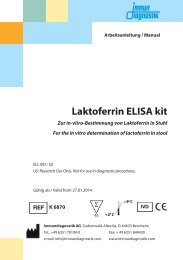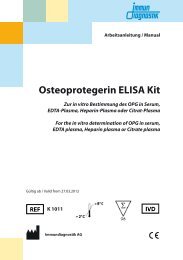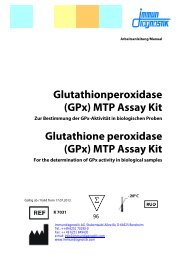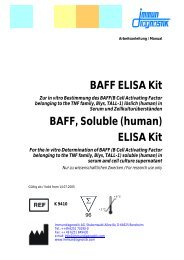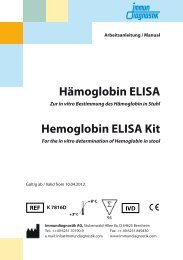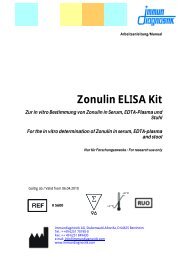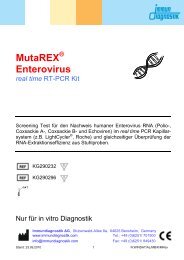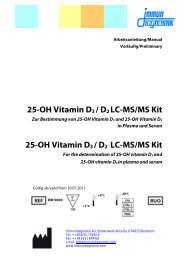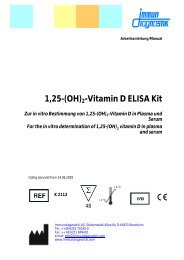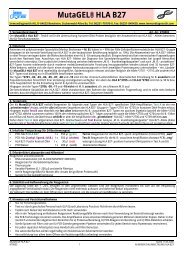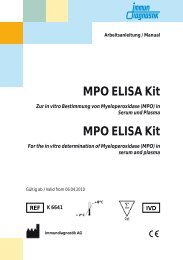Vitamin A/E HPLC Kit - Labodia
Vitamin A/E HPLC Kit - Labodia
Vitamin A/E HPLC Kit - Labodia
Sie wollen auch ein ePaper? Erhöhen Sie die Reichweite Ihrer Titel.
YUMPU macht aus Druck-PDFs automatisch weboptimierte ePaper, die Google liebt.
KC 1600<br />
Immundiagnostik AG<br />
Stubenwald-Allee 8a<br />
D-64625 Bensheim<br />
Arbeitsanleitung / Manual<br />
<strong>Vitamin</strong> A/E <strong>HPLC</strong> <strong>Kit</strong><br />
Zur Bestimmung von <strong>Vitamin</strong> A/E in Plasma und Serum<br />
For the determination of <strong>Vitamin</strong> A/E in Plasma und Serum<br />
Gültig ab / Valid from 08.04.2008
<strong>HPLC</strong>-Analytik / <strong>HPLC</strong> analytics <strong>Vitamin</strong> A/E<br />
Inhalt<br />
1. VERWENDUNGSZWECK _________________________________________________ 2<br />
2. EINLEITUNG ___________________________________________________________ 2<br />
3. TESTPRINZIP ___________________________________________________________ 2<br />
4. INHALT DER TESTPACKUNG ______________________________________________ 3<br />
5. ERFORDERLICHE LABORGERÄTE UND HILFSMITTEL _________________________ 4<br />
6. VORBEREITUNG UND LAGERUNG DER REAGENZIEN _________________________ 4<br />
7. HINWEISE UND VORSICHTSMASSNAHMEN _________________________________ 4<br />
8. PROBENVORBEREITUNG _________________________________________________ 4<br />
Hinweise _______________________________________________________________ 5<br />
Arbeitsschema __________________________________________________________ 5<br />
Chromatographische Bedingungen __________________________________________ 6<br />
10. BEHANDLUNG DER TRENNSÄULE _________________________________________ 6<br />
11. AUSWERTUNG _________________________________________________________ 6<br />
Berechnung ____________________________________________________________ 6<br />
Musterchromatogramm ___________________________________________________ 7<br />
12. EINSCHRÄNKUNGEN ____________________________________________________ 7<br />
13. QUALITÄTSKONTROLLE _________________________________________________ 7<br />
14. TESTCHARAKTERISTIKA _________________________________________________ 8<br />
Präzision und Reproduzierbarkeit ____________________________________________ 8<br />
Linearität ______________________________________________________________ 8<br />
Nachweisgrenze _________________________________________________________ 8<br />
Wiederfindung __________________________________________________________ 8<br />
15. ENTSORGUNG _________________________________________________________ 9<br />
16. MASSNAHMEN BEI STÖRUNGEN __________________________________________ 9<br />
17. LITERATUR ___________________________________________________________ 10<br />
18. ALLGEMEINE HINWEISE ZUM TEST _______________________________________ 11<br />
1
<strong>HPLC</strong>-Analytik / <strong>HPLC</strong> analytics <strong>Vitamin</strong> A/E<br />
1. VERWENDUNGSZWECK<br />
Die <strong>HPLC</strong>-Applikation ist für die Bestimmung von <strong>Vitamin</strong> A/E in Serum und Plasma geeignet.<br />
Nur zur in vitro Diagnostik.<br />
2. EINLEITUNG<br />
Die <strong>Vitamin</strong>e A und E gehören zu den fettlöslichen <strong>Vitamin</strong>en und können über einen längeren<br />
Zeitraum im Fettgewebe gespeichert werden. Sowohl Über- als auch Unterversorgung<br />
von den <strong>Vitamin</strong>en A und E können sich in Beschwerden äußern.<br />
<strong>Vitamin</strong> A (Retinol) ist für den Sehprozess unerlässlich und hält die Haut und Schleimhäute<br />
gesund. Ein Mangel an <strong>Vitamin</strong> A kann daher Einfluß auf die Sehkraft haben, besonders bei<br />
Übergängen von hell zu dunkel. Ein schwerer <strong>Vitamin</strong> A Mangel kann zur Erblindung führen.<br />
Bei zu hohen Dosen kann es aber auch pathologisch wirken und Kopfschmerzen, Hautveränderungen,<br />
Leberschädigungen, schmerzhafte Skelettveränderungen und Fruchtschädigungen<br />
verursachen.<br />
Das <strong>Vitamin</strong> E (Tocopherol) schützt als natürliches Antioxidans die ungesättigten Fettsäuren<br />
vor der Oxidation. Es fängt die Radikale ab, bevor sie zerstörend auf die Zelle einwirken<br />
können.<br />
Ein Mangel an <strong>Vitamin</strong> E zeigte im Tierversuch eine Schädigung der Muskulatur, des Nervensystems<br />
und Herzens, der Leber und der Fortpflanzung. Beim Menschen wurden derartige<br />
Auswirkungen nicht beobachtet. <strong>Vitamin</strong> E kann in großen Mengen im Fettgewebe gespeichert<br />
werden. Zu einer Unterversorgung kann es durch eine gestörte Fettverdauung oder<br />
-resorption kommen.<br />
3. TESTPRINZIP<br />
Zur Bestimmung der <strong>Vitamin</strong>e A und E wird im ersten Schritt eine sehr einfache Probenvorbereitung<br />
durchgeführt. Den Serum- bzw. Plasmaproben wird der interne Standard zugegeben.<br />
Danach erfolgt in einem Fällungsschritt die Abtrennung höhermolekularer Substanzen.<br />
Die Trennung mittels <strong>HPLC</strong> erfolgt in einem isokratischen Verfahren bei 20-25°C auf<br />
einer„reversed phase“ Säule. Die Aufnahme der Chromatogramme erfolgt mit einem UV Detektor<br />
bei zwei verschiedenen Wellenlängen (<strong>Vitamin</strong> A: 325 nm; <strong>Vitamin</strong> E: 300 nm). Die Trennung<br />
benötigt ca. 15 Minuten für einen Lauf. Die Quantifizierung erfolgt über den mitgelieferten<br />
Standard und die Berechnung der Ergebnisse wird über die „interne Standard-Methode“<br />
anhand der Integration der Peakfläche durchgeführt.<br />
2
<strong>HPLC</strong>-Analytik / <strong>HPLC</strong> analytics <strong>Vitamin</strong> A/E<br />
Zusammenfassung<br />
Der hier vorliegende Komplettkit zur Bestimmung der <strong>Vitamin</strong>e A/E ermöglicht eine einfache,<br />
schnelle und präzise quantitative Bestimmung. Dieser Komplettkit enthält gebrauchsfertig<br />
alle Reagenzien und Verbrauchsmaterialien für die Aufbereitung der Proben und die analytische<br />
<strong>HPLC</strong>-Trennung.<br />
Wie auch bei vielen anderen Parametern liegt der Vorteil der <strong>HPLC</strong>-Analytik in der gleichzeitigen<br />
Abarbeitung vieler Analyten in einem Test. Die <strong>HPLC</strong>-System-Komplettlösung<br />
ermöglicht auch Laboratorien, die bislang noch keine Erfahrung mit Hochdruckflüssigkeitschromatographie<br />
haben, diese Technik schnell und problemlos für klinisch-chemische<br />
Routinezwecke einzusetzen. Für die Kalibrierung des Testsystems ist meist eine Einpunkt-<br />
Kalibrierung ausreichend, im Gegensatz von Immunoassays bis zu 6 Kalibratoren pro Testansatz.<br />
Eine Automatisierung der Probenaufgabe und der Auswertung ist möglich, so dass<br />
auch größere Probenzahlen fast unbeaufsichtigt abgearbeitet werden können. (Bei kurzen<br />
Serienlängen ist die Einpunktkalibrierung sehr viel wirtschaftlicher gegenüber der 6-Punkt-<br />
Kalibrierung bei Immuno-Assays).<br />
4. INHALT DER TESTPACKUNG<br />
Artikel Nr. Inhalt <strong>Kit</strong> Komponenten Menge<br />
KC1600LM MOPHA Laufmittel 1000 ml<br />
KC1600ST STD Standard (Konzentration siehe Etikett) 10 ml<br />
KC1600IS INTSTD Interner Standard 5 ml<br />
KC1600FR PREC Fällungsreagenz 50 ml<br />
KC1600VL DIL Verdünnungslösung 10 ml<br />
KC1600KO CTRL 1<br />
CTRL 2<br />
Kontrolle 1 und 2 (lyoph. 600 µl;<br />
Konzentration siehe Produktspezifikation)<br />
2 x 3 Fläschchen<br />
Die <strong>HPLC</strong> Trennsäule (KC1600RP) kann separat bei Immundiagnostik bestellt werden. Neben<br />
den kompletten <strong>Kit</strong>s können auch alle Komponenten einzeln bestellt werden. Bitte fordern Sie<br />
unsere Einzelkomponentenpreisliste an.<br />
3
<strong>HPLC</strong>-Analytik / <strong>HPLC</strong> analytics <strong>Vitamin</strong> A/E<br />
5. ERFORDERLICHE LABORGERÄTE UND HILFSMITTEL<br />
4<br />
� 1,5 ml Reaktionsgefäße (z.B. Eppendorf )<br />
� Zentrifuge<br />
� div. Pipetten (100 µl, 1000µl)<br />
� Wirbelmischer<br />
� <strong>HPLC</strong> Gerät mit UV-Detektor<br />
� reversed phase C18-Säule<br />
6. VORBEREITUNG UND LAGERUNG DER REAGENZIEN<br />
� Die CTRL 1 und CTRL 2 (Kontrolle 1 und 2) werden in 600 µl Aqua bidest. rekonstituiert.<br />
� Alle anderen Testreagenzien werden gebrauchsfertig in gelöster Form geliefert.<br />
� Die Testreagenzien sind bei Raumtemperatur, STD (Standard), INTSTD (Interner Standard),<br />
CTRL 1 und CTRL 2 (Kontrolle 1 und 2) bei -20 °C bis zum Verfallsdatum (siehe<br />
Etikett) haltbar.<br />
7. HINWEISE UND VORSICHTSMASSNAHMEN<br />
� STD (Standard), INTSTD (Interner Standard), CTRL 1 und CTRL 2 (Kontrolle<br />
1 und 2) sind auf Humanplasma aufgebaut. Sie sind auf HIV und Hepatitis<br />
B getestet und für negativ befundet worden. Jedoch sollten die Test-<br />
komponenten als Vorsichtsmaßnahme immer wie potentiell infektiöses Material<br />
behandelt werden.<br />
� Die Reagenzien dürfen nach Ablauf des Mindesthaltbarkeitsdatums nicht mehr<br />
verwendet werden.<br />
8. PROBENVORBEREITUNG<br />
Als Patientenprobe ist Plasma und Serum geeignet. Die Probe sollte in jedem Fall sofort<br />
nach der Abnahme kühl gelagert werden. Die Probe kann bei 4 °C mind. 12 Stunden<br />
(<strong>Vitamin</strong> A) bzw. 3 Tage (<strong>Vitamin</strong> E) gelagert werden. Bei –20 °C 1 Monat (<strong>Vitamin</strong> A) bzw.<br />
mind. 3 Monate (<strong>Vitamin</strong> E) stabil.
<strong>HPLC</strong>-Analytik / <strong>HPLC</strong> analytics <strong>Vitamin</strong> A/E<br />
9. TESTDURCHFÜHRUNG<br />
Hinweise<br />
� Qualitätskontrollen sollten immer mitgemessen werden.<br />
� Inkubationszeit, Temperatur und Pipettiervolumen sind vom Hersteller festgelegt. Jegliche<br />
Abweichung der Testvorschrift, die nicht mit dem Hersteller koordiniert wurde,<br />
kann zu fehlerhaften Ergebnissen führen. Immundiagnostik übernimmt keine Haftung.<br />
� Der Assay ist immer nach der im <strong>Kit</strong> beigefügten Arbeitsanleitung abzuarbeiten.<br />
Arbeitsschema<br />
1.<br />
2.<br />
3.<br />
4.<br />
In 1,5 ml Reaktionsgefäße (z.B. Eppendorf ) werden pipettiert:<br />
STD (Standard):<br />
250 µl STD<br />
(Standard)<br />
+<br />
50 µl INTSTD<br />
(interner Standard)<br />
+<br />
250 µl DIL<br />
(Verdünnungslösung)<br />
+<br />
250 µl PREC<br />
(Fällungsreagenz)<br />
Proben bzw. CTRL 1 und CTRL 2 (Kontrolle 1 und 2):<br />
250 µl Serumprobe bzw. CTRL 1 und CTRL 2<br />
(Kontrolle 1 und 2)<br />
+<br />
50 µl INTSTD<br />
(interner Standard)<br />
+<br />
500 µl PREC<br />
(Fällungsreagenz)<br />
5. Gut mischen, 30 min bei 4 °C inkubieren und 10 min bei 10.000 g zentrifu-<br />
gieren<br />
6. 100 µl in <strong>HPLC</strong>-System injizieren.<br />
5
<strong>HPLC</strong>-Analytik / <strong>HPLC</strong> analytics <strong>Vitamin</strong> A/E<br />
6<br />
Chromatographische Bedingungen<br />
Säulenmaterial: Nucleosil C18; 10 µm<br />
Säulendimension: 125 mm x 4 mm<br />
Fluß: 0,8–1,2 ml/min.<br />
UV-Detektion: <strong>Vitamin</strong> A: 325 nm<br />
<strong>Vitamin</strong> E: 300 nm<br />
Injektionsvolumen: 100 µl<br />
Laufzeit/Chromatogramm: 15 min.<br />
Temperatur: 30 °C<br />
Die Umschaltung erfolgt nach ca 7 min.<br />
Um Verschleppungen von Probe zu Probe auszuschließen ist als Spülflüssigkeit im<br />
Autosampler Laufmittel zu verwenden.<br />
Wir empfehlen die Verwendung einer Vorsäule um die Säulenhaltbarkeit zu verlängern.<br />
10. BEHANDLUNG DER TRENNSÄULE<br />
Die Säule kann nach der Analyse im MOPHA (Laufmittel) belassen werden. Vor der Analyse<br />
sollte das System mit 30 ml MOPHA (Laufmittel) äquilibriert werden.<br />
11. AUSWERTUNG<br />
Berechnung<br />
Peakhöhe Probe x Konzentration des Standards<br />
Peakhöhe Interner Standard der Probe<br />
F =<br />
Peakhöhe Interner Standard des Kalibrators<br />
Peakhöhe Kalibrator<br />
x F = Konzentration Probe
<strong>HPLC</strong>-Analytik / <strong>HPLC</strong> analytics <strong>Vitamin</strong> A/E<br />
Musterchromatogramm<br />
12. EINSCHRÄNKUNGEN<br />
Stark hämolytische, sowie lipämische Proben zeigen mitunter falsche Konzentrationen. Wir raten<br />
daher von der Messung solcher Proben ab.<br />
13. QUALITÄTSKONTROLLE<br />
<strong>Vitamin</strong> A: 200 - 800 µg/l<br />
<strong>Vitamin</strong> E: 3 - 14 mg/l<br />
Wir empfehlen, daß jedes Labor seinen eigenen Normalwerte-Bereich erstellt, weil Referenzbereiche<br />
stark von der Auswahl des Probandenkollektivs abhängig sind. Die Angabe des<br />
Normalbereichs dient lediglich der Orientierung und kann von anderen publizierten Daten<br />
abweichen.<br />
Kontrollen<br />
Zur Überwachung der Qualität der Analyse sollten bei jedem Lauf Kontrollen mitgeführt werden.<br />
Wenn eine oder mehrere Kontrollen eines Laufs ausserhalb ihres Bereichs liegen ist es<br />
möglich, dass auch die Patientenproben falsch ermittelt wurden.<br />
7
<strong>HPLC</strong>-Analytik / <strong>HPLC</strong> analytics <strong>Vitamin</strong> A/E<br />
14. TESTCHARAKTERISTIKA<br />
8<br />
Präzision und Reproduzierbarkeit<br />
Intra-Assay VK: <strong>Vitamin</strong> A: 1,9 % (0,55 mg/l) [n=6]<br />
<strong>Vitamin</strong> A: 1,2 % (1,18 mg/l) [n=6]<br />
<strong>Vitamin</strong> E: 1,5 % (9,0 mg/l) [n=6]<br />
<strong>Vitamin</strong> E: 1,1 % (14,9 mg/l) [n=6]<br />
Inter-Assay VK: <strong>Vitamin</strong> A: 4,9 % ( 0,6 mg/l) [n = 8]<br />
<strong>Vitamin</strong> A: 3,1 % ( 1,0 mg/l) [n = 8]<br />
<strong>Vitamin</strong> E: 4,6 % ( 8,3 mg/l) [n = 8]<br />
<strong>Vitamin</strong> E: 4,7 % ( 24 mg/l) [n = 8]<br />
Linearität<br />
<strong>Vitamin</strong> A: bis zu 10 mg/l<br />
<strong>Vitamin</strong> E: bis zu 50 mg/l<br />
Nachweisgrenze<br />
<strong>Vitamin</strong> A: 0,05 mg/l<br />
<strong>Vitamin</strong> E: 1 mg/l<br />
Wiederfindung<br />
<strong>Vitamin</strong> A: 98,8 %<br />
<strong>Vitamin</strong> E: 101 %
<strong>HPLC</strong>-Analytik / <strong>HPLC</strong> analytics <strong>Vitamin</strong> A/E<br />
15. ENTSORGUNG<br />
Das MOPHA (Laufmittel), PREC (Fällungsreagenz), INTSTD (interner Standard) und STD<br />
(Standard) müssen als halogenfreier Lösungsmittelabfall entsorgt werden.<br />
16. MASSNAHMEN BEI STÖRUNGEN<br />
Problemstellung Mögliche Ursache Behebung<br />
Kein Signal Keine oder defekte Verbindung<br />
zur Auswerteeinheit.<br />
Signalkabel und Anschluss<br />
prüfen.<br />
Detektorlampe zu alt Ggf. Lampe erneuern<br />
Keine Peaks Injektor verstopft Injektor überprüfen<br />
Doppelpeaks Totvolumen an Fittings und /<br />
oder Säule<br />
Fittings und / oder Säule<br />
erneuern<br />
Störpeaks Injektor verunreinigt Injektor reinigen<br />
Kontamination am Säulenkopf Säule umdrehen und 30<br />
min mit niedrigem Fluß (0,2<br />
ml/min) Laufmittel spülen<br />
Luft im System Pumpe entgasen<br />
Autosamplergefäße<br />
verunreinigt<br />
Neue oder mit Methanol<br />
gespülte Autosamplergefäße<br />
verwenden<br />
Breite Peaks, Tailing Vorsäule / Säule zu alt Neue Vorsäule / Säule verwenden<br />
9
<strong>HPLC</strong>-Analytik / <strong>HPLC</strong> analytics <strong>Vitamin</strong> A/E<br />
Problemstellung Mögliche Ursache Behebung<br />
Veränderte<br />
Retentionszeit<br />
10<br />
Temperaturdrift Säulenofen verwenden<br />
Pumpe fördert ungenau Pumpe überprüfen,<br />
entlüften<br />
System noch nicht im Gleichgewicht<br />
Basislinie driftet Detektorlampe noch kalt Warten<br />
System mit mobiler Phase<br />
15 min spülen<br />
Detektorlampe zu alt Ggf. Lampe erneuern<br />
System noch nicht im<br />
Gleichgewicht<br />
System mit mobiler Phase<br />
15 min spülen<br />
Pumpe fördert ungenau Pumpe überprüfen,<br />
entlüften<br />
Unruhige Basislinie Pumpe fördert ungenau Pumpe überprüfen,<br />
entlüften<br />
17. LITERATUR<br />
Detektorzelle verschmutzt Detektorzelle reinigen<br />
1. Sushil K.J., Mc Coy B., Wise R. (1994). <strong>Vitamin</strong> E and the hypercoagulability of neonatal<br />
blood. Clin Cim Acta 225; 97-103.<br />
2. Comstock G.W., Alberg A.J., Helzlsouer K.J. (1993). Reported effects of long-term freezer<br />
storage on concentrations of retinol, β-carotene, and α-tocopherol in serum or plasma<br />
summarised. Clin Chem 39/6; 1075-1078
<strong>HPLC</strong>-Analytik / <strong>HPLC</strong> analytics <strong>Vitamin</strong> A/E<br />
18. ALLGEMEINE HINWEISE ZUM TEST<br />
� Dieser <strong>Kit</strong> wurde nach der IVD Richtlinie 98/79/EG hergestellt und in den Verkehr gebracht.<br />
� Reagenzien dieser Testpackung enthalten organische Lösungsmittel. Berührungen mit<br />
der Haut oder den Schleimhäuten sind zu vermeiden.<br />
� Sämtliche in der Testpackung enthaltene Reagenzien dürfen ausschließlich zur in-vitro-Diagnostik<br />
eingesetzt werden.<br />
� Die Reagenzien sollten nach Ablauf des Verfallsdatums nicht mehr verwendet werden<br />
(Verfallsdatum siehe Testpackung).<br />
� Einzelkomponenten mit unterschiedlichen Lot-Nummern aus verschiedenen Testpackungen<br />
sollten nicht gemischt oder ausgetauscht werden.<br />
� Für die Qualitätskontrolle sind die dafür erstellten Richtlinien für medizinische Laboratorien<br />
zu beachten.<br />
� Die charakteristischen Testdaten wie Pipettiervolumina der verschiedenen Komponenten<br />
und der Aufbereitung der Proben wurden firmenintern festgelegt. Nicht mit<br />
dem Hersteller abgesprochene Veränderungen in der Testdurchführung können die<br />
Resultate beeinflussen. Die Firma Immundiagnostik AG übernimmt für direkt daraus<br />
resultierende Schäden und Folgeschäden keine Haftung.<br />
Verwendete Symbole:<br />
Temperaturbegrenzung Bestellnummer<br />
In-Vitro-Diagnostikum<br />
Inhalt ausreichend für <br />
Prüfungen<br />
Hersteller Verwendbar bis<br />
Chargenbezeichnung<br />
11
<strong>HPLC</strong>-Analytik / <strong>HPLC</strong> analytics <strong>Vitamin</strong> A/E<br />
12
Manual<br />
<strong>Vitamin</strong> A/E <strong>HPLC</strong> <strong>Kit</strong><br />
For the determination of <strong>Vitamin</strong> A/E in Plasma und Serum<br />
Valid from 08.04.2008<br />
KC 1600<br />
Immundiagnostik AG<br />
Stubenwald-Allee 8a<br />
D-64625 Bensheim
<strong>HPLC</strong>-Analytik / <strong>HPLC</strong> analytics <strong>Vitamin</strong> A/E<br />
Content<br />
1. INTENDED USE ________________________________________________________ 15<br />
2. INTRODUCTION _______________________________________________________ 15<br />
3. PRINCIPLE OF THE TEST ________________________________________________ 15<br />
4. MATERIAL SUPPLIED ___________________________________________________ 16<br />
5. MATERIAL REQUIRED BUT NOT SUPPLIED _________________________________ 17<br />
6. PREPARATION AND STORAGE OF REAGENTS ______________________________ 17<br />
7. PRECAUTIONS ________________________________________________________ 17<br />
8. SPECIMEN COLLECTION AND PREPARATION _______________________________ 17<br />
9. ASSAY PROCEDURE ____________________________________________________ 18<br />
Procedural notes ________________________________________________________ 18<br />
Sample and standard preparation __________________________________________ 18<br />
Chromatographic conditions ______________________________________________ 19<br />
10. TREATMENT OF THE COLUMN ___________________________________________ 19<br />
11. RESULTS _____________________________________________________________ 19<br />
Calculation ____________________________________________________________ 19<br />
Typical chromatogram ___________________________________________________ 20<br />
12. LIMITATIONS __________________________________________________________ 20<br />
13. QUALITY CONTROL ____________________________________________________ 20<br />
14. PERFORMANCE CHARACTERISTICS ______________________________________ 21<br />
Precision and reproducibility ______________________________________________ 21<br />
Linearity ______________________________________________________________ 21<br />
Detection limit _________________________________________________________ 21<br />
Recovery ______________________________________________________________ 21<br />
15. DISPOSAL ____________________________________________________________ 21<br />
16. TROUBLESHOOTING ___________________________________________________ 22<br />
17. REFERENCES __________________________________________________________ 23<br />
18. GENERAL NOTES ON THE TEST AND TEST PROCEDURE ______________________ 23<br />
14
<strong>HPLC</strong>-Analytik / <strong>HPLC</strong> analytics <strong>Vitamin</strong> A/E<br />
1. INTENDED USE<br />
The Immundiagnostik Assay is intended for the quantitative determination of <strong>Vitamin</strong> A/E in<br />
serum and plasma. This Assay is designed for in vitro diagnostic use only.<br />
2. INTRODUCTION<br />
<strong>Vitamin</strong> A (Retinol) and <strong>Vitamin</strong> E (Tocopherol) are fat-soluble vitamins, which could be stored<br />
for longer periods in the adipose tissue. Both, lack and excess could express in complaints.<br />
<strong>Vitamin</strong> A is essential for the visual process and recovers the skin and mucosa. A lack of<br />
<strong>Vitamin</strong> A will reduce the visual power up to total blindness. An excess of <strong>Vitamin</strong> A could<br />
cause headache, damage of the skin, liver disease, painful alteration in the skeleton or foetal<br />
damage.<br />
<strong>Vitamin</strong> E (Tocopherol) is an antioxidant and protects unsaturated fatty acids against<br />
oxidation. It also protects the cells of the body by catching radicals.<br />
A lack of vitamin E in animal experiments demonstrates diseases of muscle, nervous system,<br />
heart, liver and reproduction system. These symptoms were not observed in humans. <strong>Vitamin</strong><br />
E can be stored in the adipose tissue in large amounts. A lack can be caused by a malfunction<br />
in digestion or resorption of fatty acids.<br />
3. PRINCIPLE OF THE TEST<br />
The first step in the determination of <strong>Vitamin</strong> A and E includes the sample preparation. In the<br />
first step an internal standard solution is added. During the precipitation higher molecular<br />
substances are removed. After centrifugation the supernatant is used for injection into the<br />
<strong>HPLC</strong> system.<br />
The separation via <strong>HPLC</strong> follows an isocratic method at 30°C using a „reversed phase“ column;<br />
one run lasts 15 minutes. The detection is performed by an UV detector at two different wavelengths<br />
(<strong>Vitamin</strong> A: 325 nm; <strong>Vitamin</strong> E: 300 nm). The quantification is performed with the delivered<br />
standard solution; the concentration is calculated via integration of the peak areas in the<br />
internal standard calibration mode.<br />
15
<strong>HPLC</strong>-Analytik / <strong>HPLC</strong> analytics <strong>Vitamin</strong> A/E<br />
Summary:<br />
The application of <strong>Vitamin</strong> A and E for <strong>HPLC</strong> allows the determination of both vitamins in an<br />
easy, fast, and precise method. The kit includes all reagents in ready to use form for preparation<br />
and separation of the samples with exception of the columns.<br />
As many other parameters the advantage of <strong>HPLC</strong> analysis is the simultaneous handling of<br />
many analytes in a single test. The <strong>HPLC</strong> complete system enables even laboratories without<br />
experience in „high performance liquid chromatography“ to use this technique for clinical<br />
chemical routines quickly and precisely. Mostly a one-point calibration is sufficient for calibrating<br />
the test system - unlike immuno assays with up to 6 calibrators per test. It is possible to<br />
automate the sample application and calculation of the results so that even higher number of<br />
samples can be handled nearly without control. (With short test series the one-point calibration<br />
is much more economic than 6-point calibration for immuno assays).<br />
4. MATERIAL SUPPLIED<br />
16<br />
Catalogue No Content <strong>Kit</strong> Components Quantity<br />
KC1600LM MOPHA<br />
Mobile phase<br />
1000 ml<br />
KC1600ST STD Standard (conc. is given on the label) 10 ml<br />
KC1600IS INTSTD Internal Standard 5 ml<br />
KC1600FR PREC Precipitation reagent 50 ml<br />
KC1600VL PREC Dilution solution 10 ml<br />
KC1600KO CTRL 1<br />
CTRL 2<br />
Control 1 and 2; 600 µl lyophilized<br />
2 x 3 Fläschchen<br />
<strong>HPLC</strong> column (KC1600RP) as well as individual components can be ordered separately from<br />
Immundiagnostik. Please ask for the price list of the individual components.
<strong>HPLC</strong>-Analytik / <strong>HPLC</strong> analytics <strong>Vitamin</strong> A/E<br />
5. MATERIAL REQUIRED BUT NOT SUPPLIED<br />
� 1.5 ml reaction tubes (Eppendorf )<br />
� Centrifuge<br />
� Various pipettes<br />
� <strong>HPLC</strong> with UV-detector<br />
� Reversed phase C18-column<br />
6. PREPARATION AND STORAGE OF REAGENTS<br />
� Reconstitute CTRL 1 and CTRL 2 (control 1 and 2) in 600 µl aqua bidest.<br />
� All other reagents are ready to use and become delivered in soluble form.<br />
� All reagents are stable at 20-25 °C; STD (standard), CTRL 1 and CTRL 2 (control 1<br />
and 2) and INTSTD (internal standard) at -20 °C up to the date of expiry (see label of<br />
the test package).<br />
7. PRECAUTIONS<br />
� For in vitro diagnostic use only.<br />
� This product contains human source material which was tested and found to be<br />
non-reactive to HBsAg, anti-HIV-1/2, and anti-HCV. Since no method can offer complete<br />
assurance that hepatitis B virus, HIV-1/2, HVC or other infectious agents are absent,<br />
these reagents should be handled as if potentially infectious.<br />
� Reagents should not be used beyond the expiration date shown on kit label.<br />
8. SPECIMEN COLLECTION AND PREPARATION<br />
Serum and EDTA-plasma are suited as samples.<br />
The sample is light- and temperature sensitive; therefore samples have to be protected<br />
from light and cooled and centrifuged immediately.<br />
The samples are stable in the dark at 2-8°C for 12 h (<strong>Vitamin</strong> A) and 48 h (<strong>Vitamin</strong> E).<br />
At -20°C <strong>Vitamin</strong> A is stable for 1 month, <strong>Vitamin</strong> E for 3 month.<br />
17
<strong>HPLC</strong>-Analytik / <strong>HPLC</strong> analytics <strong>Vitamin</strong> A/E<br />
9. ASSAY PROCEDURE<br />
18<br />
Procedural notes<br />
� The quality control guidelines should be observed.<br />
� Incubation time, incubation temperature and pipetting volumes of the different<br />
components are defined by the producer. Any variations of the test procedure, that are<br />
not coordinated with the producer, may influence the test results. Immundiagnostik<br />
can therefore not be held reliable for any damage resulting from this.<br />
� The assay should always be performed due to the manual which is given in the kit.<br />
Sample and standard preparation<br />
1.<br />
2.<br />
3.<br />
4.<br />
Pipette into 1.5 ml reaction tubes:<br />
STD (Standard):<br />
250 µl STD<br />
(standard solution)<br />
+<br />
50 µl INTSTD<br />
(internal standard solution)<br />
+<br />
250 µl DIL<br />
(dilution solution)<br />
+<br />
250 µl PREC<br />
(precipitation solution)<br />
Samples, CTRL 1 and CTRL 2 (control 1 and 2)<br />
250 µl sample or CTRL 1, CTRL 2<br />
(control 1, 2)<br />
+<br />
50 µl INTSTD<br />
(internal standard solution)<br />
+<br />
500 µl PREC<br />
(precipitation solution<br />
5. Mix well. Leave the tubes for 30 minutes at 2-8°C and centrifuge afterwards at<br />
10.000g for 10 minutes.<br />
6. Inject 100 µl of the supernatant for chromatography into the <strong>HPLC</strong>-system.
<strong>HPLC</strong>-Analytik / <strong>HPLC</strong> analytics <strong>Vitamin</strong> A/E<br />
Chromatographic conditions<br />
Column material: Nucleosil C18; 10 µm<br />
Column dimension: 125 x 4 mm<br />
Flow rate: 0.8–1.2 ml/min<br />
Detection: UV<br />
<strong>Vitamin</strong> A: 325 nm<br />
<strong>Vitamin</strong> E: 300 nm<br />
Injection volume: 100µl<br />
Running time: 15 minutes<br />
Temperature: 30°C<br />
The wavelength should be switched after 7 min.<br />
To avoid contamination of the next run, MOPHA (mobile phase) must be used to<br />
wash the auto sampler.<br />
Immundiagnostik recommends to use a guard-column to enlarge lifetime of the<br />
column.<br />
10. TREATMENT OF THE COLUMN<br />
After analysis, the column could be left in MOPHA (mobile phase). Before use, the system<br />
should be equilibrated with ca. 30 ml MOPHA (mobile phase).<br />
11. RESULTS<br />
Calculation<br />
Peak height sample x Concentration of the calibrator<br />
Peak height internal standard in the sample<br />
F =<br />
x F = Concentration sample<br />
Peak height internal standard in the calibrator<br />
Peak height calibrator<br />
19
<strong>HPLC</strong>-Analytik / <strong>HPLC</strong> analytics <strong>Vitamin</strong> A/E<br />
20<br />
Typical chromatogram<br />
12. LIMITATIONS<br />
Hemolytic and lipemic samples should not be measured<br />
13. QUALITY CONTROL<br />
Expected values <strong>Vitamin</strong> A: 200 - 800 µg/l<br />
<strong>Vitamin</strong> E: 3 - 14 mg/l<br />
We recommend, that each laboratory should develop their own normal range. The values<br />
mentioned above are only for orientation and can deviate from other published data.<br />
Controls<br />
Control samples or serum pools should be analyzed with each run of calibrators and<br />
patient samples. Results generated from the analysis of the control samples should be<br />
evaluated for acceptability using appropriate statistical methods. In assays in which one<br />
or more of the quality control sample values lie outside the acceptable limits, the results<br />
for the patient sample may not be valid.
<strong>HPLC</strong>-Analytik / <strong>HPLC</strong> analytics <strong>Vitamin</strong> A/E<br />
14. PERFORMANCE CHARACTERISTICS<br />
Precision and reproducibility<br />
Intra-Assay VK: <strong>Vitamin</strong> A: 1,9 % (0,55 mg/l) [n=6]<br />
<strong>Vitamin</strong> A: 1,2 % (1,18 mg/l) [n=6]<br />
<strong>Vitamin</strong> E: 1,5 % (9,0 mg/l) [n=6]<br />
<strong>Vitamin</strong> E: 1,1 % (14,9 mg/l) [n=6]<br />
Inter-Assay VK: <strong>Vitamin</strong> A: 4,9 % ( 0,6 mg/l) [n = 8]<br />
<strong>Vitamin</strong> A: 3,1 % ( 1,0 mg/l) [n = 8]<br />
<strong>Vitamin</strong> E: 4,6 % ( 8,3 mg/l) [n = 8]<br />
<strong>Vitamin</strong> E: 4,7 % ( 24 mg/l) [n = 8]<br />
Linearity<br />
<strong>Vitamin</strong> A: up to 10 mg/l<br />
<strong>Vitamin</strong> E: up to 50 mg/l<br />
Detection limit<br />
<strong>Vitamin</strong> A: 0.05 mg/l<br />
<strong>Vitamin</strong> E: 1 mg/l<br />
Recovery<br />
<strong>Vitamin</strong> A: 98.8 %<br />
<strong>Vitamin</strong> E: 101 %<br />
15. DISPOSAL<br />
MOPHA (mobile phase), PREC (precipitation reagent), INTSTD (internal standard) and STD<br />
(standard) must be disposed as non-halogenated solvent.<br />
Please refer to the appropriate national guidelines.<br />
21
<strong>HPLC</strong>-Analytik / <strong>HPLC</strong> analytics <strong>Vitamin</strong> A/E<br />
16. TROUBLESHOOTING<br />
Problem Possible reasons Solution<br />
No signal<br />
22<br />
No or defect connection to<br />
evaluation system.<br />
Check signal cord and<br />
connection.<br />
Detector lamp is altered Change lamp<br />
No peaks Injector is congested Check Injector<br />
Double peaks Dead volume in fittings and /<br />
or column<br />
Contaminating<br />
peaks<br />
Renew fittings and / or<br />
column<br />
Injector dirty Clean injector<br />
Contamination at the head of<br />
the column<br />
Air in the system Degas pump<br />
Autosampler vials contaminated<br />
Change direction of the<br />
column and rinse for 30 min<br />
at low flow rate (0.2 ml/min)<br />
with mobile phase<br />
Use new vials or clean them<br />
with methanol<br />
Broad peaks, tailing Precolumn / column exhausted Use new precolumn /<br />
column<br />
Variable retention<br />
times<br />
Drift in temperature Use a column oven<br />
Pump delivers imprecise Check pump, degas the<br />
system<br />
System is not in steady state<br />
yet<br />
Baseline is drifting Detector lamp did not reach<br />
working temperature yet<br />
Detector lamp is too old Renew lamp<br />
System is not in steady state<br />
yet<br />
Rinse system mobile phase<br />
for 15 min<br />
Wait<br />
Rinse system mobile phase<br />
for 15 min<br />
Pump delivers imprecise Check pump, degas the<br />
system
<strong>HPLC</strong>-Analytik / <strong>HPLC</strong> analytics <strong>Vitamin</strong> A/E<br />
Problem Possible reasons Solution<br />
Baseline is not calm Pump delivers imprecise Check pump, degas the<br />
system<br />
Detector flow cell is dirty Clean flow cell<br />
17. REFERENCES<br />
1. Sushil K.J., Mc Coy B., Wise R. (1994). <strong>Vitamin</strong> E and the hypercoagulability of neonatal<br />
blood. Clin Cim Acta 225; 97-103.<br />
2. Comstock G.W., Alberg A.J., Helzlsouer K.J. (1993). Reported effects of long-term freezer<br />
storage on concentrations of retinol, β-carotene, and α-tocopherol in serum or plasma<br />
summarized. Clin Chem 39/6; 1075-1078.<br />
18. GENERAL NOTES ON THE TEST AND TEST PROCEDURE<br />
� This assay was produced and put on the market according to the IVD guidelines of<br />
98/79/EC.<br />
� The test components contain organic solvents. Contact with skin or mucous membranes<br />
has to be avoided.<br />
� All reagents in the test package are to be used for research only.<br />
� The reagents should not be used after the date of expiry stated on the label.<br />
� Single components with different lot numbers should not be mixed or exchanged.<br />
� The guidelines for medical laboratories should be observed.<br />
� Incubation time, incubation temperature and pipetting volumes of the different components<br />
are defined by the producer. Any variations of the test procedure, that are not<br />
coordinated with the producer, may influence the results of the test. Immundiagnostik<br />
AG can therefore not be held reliable for any damage resulting from this.<br />
23
<strong>HPLC</strong>-Analytik / <strong>HPLC</strong> analytics <strong>Vitamin</strong> A/E<br />
24<br />
Used Symbols:<br />
Store at Catalog Number<br />
In Vitro Diagnostic Device No. of tests<br />
Manufacturer Use by<br />
Lot number
Immundiagnostik AG<br />
Stubenwald-Allee 8a<br />
D-64625 Bensheim<br />
Tel.: +49 (0) 62 51/70 19 00<br />
Fax: +49 (0) 62 51/84 94 30<br />
info@immundiagnostik.com<br />
www.immundiagnostik.com



